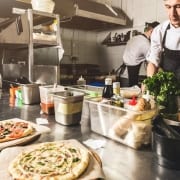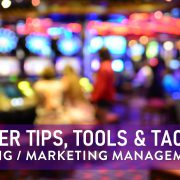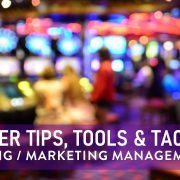MARKETING YOUR RESTAURANT POST-LOCKDOWN
When restrictions start to ease across the country for vaccinated customers, clubs & pubs, cafes, restaurants and bars will slowly re-open their doors to the public. But in the aftermath of COVID-19, nothing seems to be quite the same. Businesses that survived the lockdown, now face a new challenge: adapting to the new normal with only vaccinated customers, some who will want to wait to see what happens as case numbers increase.
Here’s a handy guide from Anchor Digital on post-COVID marketing strategies for the hospitality industry.
While many cafes, restaurants and bars were able to survive this truly trying time, not all were so lucky. The Australian industry association estimates that 10 per cent of hospitality businesses had to permanently close their doors due to COVID-19 after the 2020 lockdowns. And the ones that made it through the 2021 lockdowns aren’t out of the woods yet.
We acknowledge that this pandemic’s impact on cash flow and profitability of many businesses is far and widespread, and that no one solution can be the answer to all of your worries. Instead, hospitality leaders will have to take a wide range of proactive steps to mitigate the impact of this crisis on their livelihoods and that of their employees.
In most cases, marketing budgets will be tighter than ever before. But, using all the marketing tools available to you will be critical for the success of your business. So let’s have a look at how you can thoughtfully address common concerns and let people know you’re still there for them, trading and welcoming anyone walking through your door.
Understanding Customer Behaviour and Changed Expectations
To plan your marketing initiatives whilst the country rises from its pandemic slumber state, you first need to understand how your customers’ behaviour changed over the course of the lockdowns.
COVID-19 has introduced a range of new variables, making it more challenging to take the right measures. People are accustomed to social distancing. They’re now more than ever before, ordering takeaway or relying on delivery services. Everyone is using contactless payment options and paying attention to the measurements businesses are taking to ensure the safety of their customers and staff.

Source: Datassentials
According to research conducted by AMC Global, the impact on most hospitality businesses will be far and wide stretching. Here is what you need to take into account:
- 39 per cent of consumers are nervous, but will still eat out when restrictions ease
- 32 per cent of consumers plan to cook more home-made meals in the future
- 89 per cent of consumers perceive home-made food as saver compared to a restaurant or other away from home options
- 38 per cent of consumers say they’ll focus more on supporting local businesses after the virus passes
- 40 per cent of consumers say they plan to focus more on saving and budgeting their money
Staying Agile in Times of Uncertainty
As the world is dealing with the aftermath of COVID-19, the primary focus for both governments and businesses still rests on the safety of the people. Hence, rules and restrictions can change quickly, sometimes from one day to another. Both Victoria and NSW has had to repeatedly push back plans to reopen pubs and restaurants as infections surged.
Adapting hasn’t been easy, not for the hospitality industry nor the people that miss brunch at their favourite cafe or having a pint at their local pub. But as the first weeks of quarantine have shown us, both sides are able to change their ways and respect new rules as they are put in place to keep us all healthy and safe.
While COVID-19 has been a traumatizing experience for the restaurant industry, many businesses have been able to weather the storm by shifting to takeaway options and using digital platforms like social media and websites to let people know about changes in their offering.
Joe Blanton, co-founder of Krush Burger International and director of sales at Capital Rivers Commercial commented on the uncertain situation in a recent podcast: “Even if you adapted this week, it’s quite possible you may have to re-adapt the following week. What I believe restaurant operators should be looking into are ways they can embrace technology [to help with the constant need for change].” Said technology can not only offer you great insight into people’s changed behaviour but help you stay flexible while reaching your consumers in meaningful ways.

Hygiene And Food Safety – The Number One Priority for All
In a post-COVID world, a restaurant’s hygiene standards seem to increasingly beat taste when people are checking out online ratings. In 2020, people were more likely to trust a business that was transparent about their sanitation and hygiene standards and the actions they took to minimize the risk of spreading a disease. After this recent round of lockdowns and the thought f reopening with cases in the community to vaccinated customers, hygiene standards and visible cleaning operations will be vital.
The restaurant search and discovery guide Zomato recently reported that its users are increasingly focusing on the app’s hygiene ratings of restaurants they’re interested in. Businesses with strong hygiene ratings see as much as a 25 per cent increase in orders through the app.
“Your marketing message in the post-COVID era will be less about your chicken and more about hygiene. Hygiene will change after the COVID-19 pandemic the way security changed after the 9/11 terror attacks”, says Anurag Katiyar, president of the National Restaurant Association of India in a recent interview on the food safety equinox.
Safety is and always has been your top priority? Then communicate that openly! Let your customers know what you’re doing to stay on top of the new regulations and to make sure that everyone’s staying healthy.
Digital Solutions to the Rescue
Once you have gained a better understanding of the changing customer demands concerning health and safety, you can start planning your next steps. As states begin to reopen businesses, social distancing guidelines, and vaccination status, will dictate capacity restrictions and limits to party sizes. Online reservations and virtual waitlists are coming to the rescue, helping you to organise yourself.
New technologies change the ways in which people dine. In a post-COVID world, they’re also likely to affect every other aspect of your business. A great example: Loyalty programs and food menus that use QR codes. They can be downloaded onto mobile devices to eliminate the risk of transmission via print menus or cards that go through hundreds of hands every week.
Up Your Social Media Game
Assuming that you’re already on top of your social media game, this might be the easiest starting point for you. It appears that successful businesses are based on the quality of their social media following. That holds true for hospitality too, especially when it comes to informing customers about changed trading hours and new menus.
While you have fewer walk-ins and can only welcome a restricted number of dine-in guests, focus your attention on making yourself known and attracting future customers. Maybe you have a little more time than you did previously and can take high-quality images of your space and your menu. But while you’re showing yourself in the best light, make sure not to be tone-deaf and ignore reality. Instead, position your restaurant as a safe place to come together after the lockdown.
Feeding your followers “food porn” as they’re stuck at home, might seem a little mean, but it’s also the secret to making your kitchen stay busy when dine-in options are still restricted. Plus, every new fan you’ve gained and filled with food-envy throughout quarantine will be knocking on your door as soon as they’re allowed to safely do so again.
Our key tips on promoting your business via social media:
- Take original, high-quality food photos.It’ll help you stand out amongst your competitors. Social media is flooded with great food images and hiring a photographer will pay off in the long run.
- Plan ahead. We know you’re super busy once the service is on. Having a content plan for each week will be a huge relief. Many tools will automatically post for you, so you don’t have to worry about it while you’re running the show.
- Be consistent. Post to your feed every day and as many stories as you like. Stories are much less curated, can be more spontaneous and give your followers an insight into your daily operations.
- Be smart about your timing. Post brekkie options the night before or super early in the morning, dinner items mid-morning. Give your customers time to think about their next meal and plan ahead.
Run a Facebook & Instagram Promotion
Here are a few tips for setting up a Facebook and Instagram ad campaign using the Facebook Business Manager:
- Start with an “engagement campaign” to create awareness: First things first, you’ll want to let people know that you exist. Optimising for “page likes” will not only get you in front of people but also boost your posts in their newsfeeds moving forward. And the more they see of you, the more likely they are to end up popping in for a treat.
- Keep it local:Create an ad group that targets people who live within 5 km of your restaurant, bar or cafe. If you’re based in the city centre, you may want to include areas which your customers could travel in from.
- Know your customers:Limit your audience to your target age range. There is very little point targeting young adults if you’re mostly serving 50+.
- Target a “lookalike audience”, based on who is already following you on Social Media. The algorithm will then find people similar to your fans and get you in front of them.
- Use retargeting for existing customers:Create a custom audience targeting people who have visited you before. Again, your loyal customers may not know that you’re trading again.
- Get creative:Create a carousel advertisement with images of your top three best selling dishes. You’re going to make people hungry by looking at the images alone.
Send a Newsletter (or Two or Three) to Your Customers
You’re sitting on top of a lot of unused customer data? What a waste! Email marketing should be at the core of your marketing strategy during this period. Now is the perfect time to reach out to your already “warm audience”. Let them know that you’re open for business again and excited to welcome them back. Email marketing may seem a little old school to some, but it hasn’t lost its effectiveness in terms of cost and return.
Update Your Google My Business Listing
Your strategy to deal with all things Google is very much “out of sight, out of mind”? That’s a terrible idea! Google is still the first place people turn to when looking for a place to dine and frequently updating your listing is the key to ensuring all information is still correct. That holds especially true, considering the fact that anyone can edit your opening hours or contact details – without notifying you!
During and after COVID-19, your trading hours and offering will most likely vary, make sure you stay on top of updating your information accordingly to avoid confusion. And, make sure you have any booking platforms integrated correctly. Nothing is more frustrating during times of restricted dine-in allowances than having a party of four with a reservation show up at 6 pm on Saturday night when you were never notified of the booking.
Food for Thought
COVID-19 is transforming hospitality as we know it. Measures such as the wearing of masks, social distancing, contactless engagement and the preference of cash-free transactions, will stick around.
There is a great opportunity in using these challenges to push towards a landscape shift. The fact that regulations and customer behaviour can change at any given time, creates the need to stay flexible and keep adapting.
Innovative technologies and digital marketing tools will fundamentally change how businesses operate and can help restaurants, bars and cafes quickly and successfully adapt to the “new normal”.
Adapted for industry from: https://anchordigital.com.au/successfully-marketing-your-restaurant-post-covid-19-and-re-opening-to-the-public/













